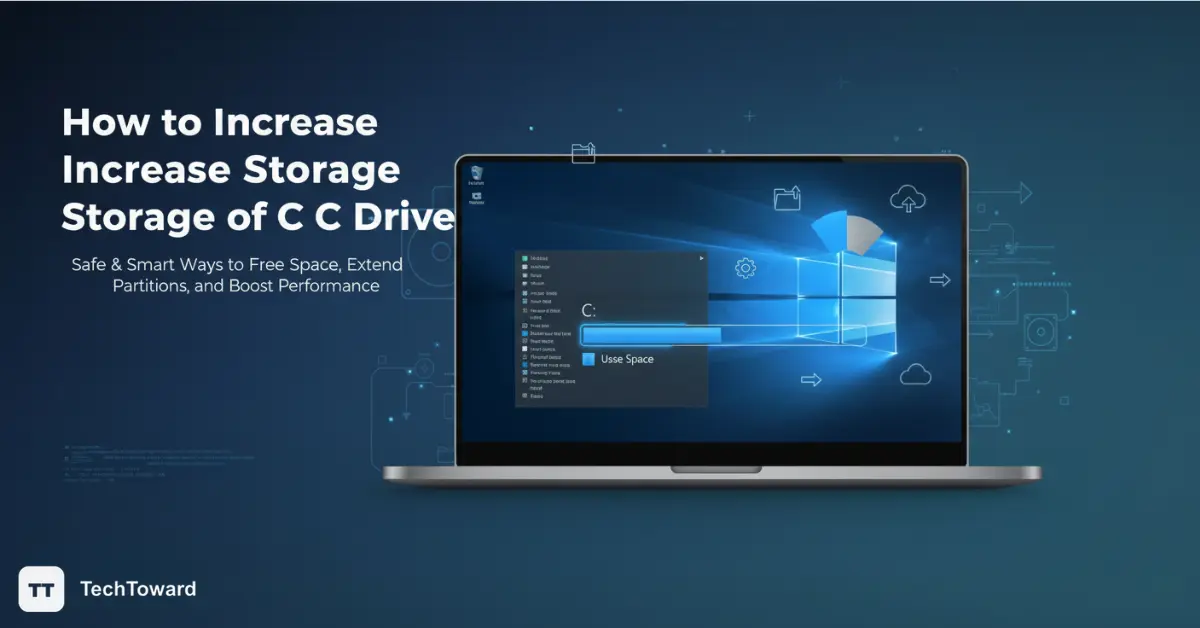How to increase storage of C drive may seem tricky, but with the right mix of cleanup, partitioning tools, and smart moves, you can gain extra space on your C drive in a safe and efficient way.
✅ What Does “Increasing Storage of C Drive” Mean?
Your C drive is usually where Windows and your core programs are installed. Over time, it fills up because of system updates, installed apps, caches, and user files. When C drive is near full, performance slows, and you may see “low disk space” warnings.
Increasing C drive storage doesn’t necessarily mean adding a brand-new drive — you can often reallocate existing disk space or clean up unnecessary data. In some cases, you may opt for adding or replacing with a larger physical drive or SSD.
This article walks you through basic to more advanced methods, with step-by-step guidance and best practices to keep your data safe.
🧰 Basic Methods
These are techniques you can try right now without advanced tools or risking your setup too much.
1. Free Up Space via Cleanup & File Management
Often the easiest gains come from removing or relocating files:
- Disk Cleanup / Storage Sense
Use Windows built-in tools: Start → Settings → System → Storage → “Free up space” or “Storage Sense.” Remove temporary files, old Windows installations, recycle bin items.
- Uninstall Unused Programs
Go to Apps → Apps & Features, and remove software you no longer use.
- Move Large Files to Another Drive or External Storage
Videos, photos, downloads often take the bulk of space. Move them to D: (or another partition) or external drive (USB, NAS).
- Use Cloud Storage / OneDrive Files On-Demand
You can offload files you don’t access often to the cloud, keeping only small placeholders locally.
- Redirect System Folders (Documents, Downloads, etc.)
In File Explorer, right-click on folders like Documents → Properties → Location tab → Move. This shifts the physical storage off C.
These steps often free up enough space to make your system usable again.
🧠 Intermediate / Advanced Methods
Once you’ve freed space, the next level is partition resizing or disk upgrade.
2. Use Disk Management to Extend the C Drive
Windows has a built-in utility called Disk Management. But it has limitations:
- The unallocated (free) space must be immediately next to (to the right of) the C partition (i.e. contiguous).
- The space must be on the same physical disk. You can’t merge two physical drives’ space.
- The volume must be NTFS (or ReFS) to extend.
Step-by-Step: Disk Management Method
- Press Windows + X → Select Disk Management.
- If you have free/unallocated space directly after C drive, right-click C → Extend Volume.
- Use the Extend Volume Wizard: choose how much space to add → Finish.
If “Extend Volume” is greyed out, it’s usually because:
- There is no unallocated space next to C.
- Another partition exists between C and the unallocated area.
- The unallocated space is on a different disk.
In those cases, Windows’ built-in tool won’t help.
3. Use Command Line: DiskPart
For more control, the diskpart utility can do similar things via command line. But same rules apply (must have adjacent unallocated space):
Example steps:
diskpart
list disk
select disk 0
list partition
select partition X (where X = your C drive)
extend size=YYYY (YYYY in MB)
exit
If space is insufficient or not adjacent, you’ll get an error.
4. Use Third-Party Partition Software (More Flexible)
When the free space is not adjacent to your C drive, or there’s another partition in the way, third-party tools can move partitions or combine noncontiguous free space. Some popular ones:
- EaseUS Partition Master – lets you drag and merge partitions.
- AOMEI Partition Assistant – can “allocate free space” from other partitions and merge it.
- Others (MiniTool Partition Wizard, etc.)
With those, you can:
- Shrink D: (or another partition) to create unallocated space.
- Move that unallocated space to adjoin C.
- Then extend C into it.
Important: always back up data before doing partition moves.
5. Upgrade / Migrate to a Larger Drive
If your current physical drive is small, you may hit a ceiling with these tricks. In that case:
- Clone your system to a larger SSD or HDD, then expand partitions. Many partition tools offer “disk clone” features.
- After cloning and booting from the new disk, you can expand the C partition more freely.
This approach gives you long-term breathing room.
🔄 Real-Life Example
I once helped a friend whose laptop had:
- C: 80 GB (almost full)
- D: 120 GB, mostly empty
We:
- Deleted old backup files and moved media from C to D (freed ~15 GB).
- Used EaseUS to shrink D by 30 GB, creating unallocated space.
- Moved that unallocated space to adjoin C (EaseUS can reposition partitions).
- Extended C into that space.
Result: C became ~110 GB, and D dropped to ~90 GB. The user noticed immediate speed improvement in Windows updates and app installs.
This method worked because the user’s D partition was on the same physical disk and there were no system partitions in between.
⚠️ Risks & Best Practices
- Always back up your data (especially system and important files) before partitioning.
- Don’t interrupt partition operations (e.g. power failure) — could corrupt disks.
- Use trusted, well-rated software if going third-party.
- Make changes when the system is idle (no heavy tasks running).
- After extending, reboot to ensure Windows fully registers new space.
- Monitor health of your disk (check S.M.A.R.T. status). Older drives can fail during complex operations.
📋 Summary Table
| Method | When to Use | Pros | Cons / Limitations |
| Disk Cleanup, uninstall, move files | Always first step | No risk, immediate gains | Limited gains |
| Disk Management (extend) | When free space is adjacent | Built-in, safe | Only works if contiguous free space |
| DiskPart (command line) | For power users | More control | Same adjacency limitation |
| Third-party partition tool | When free space is nonadjacent | Can move/merge partitions | Some risk, must use reliable software |
| Cloning to larger drive | When disk is too small overall | Big long-term space increase | Need new hardware, more effort |
❓ Frequently Asked Questions (FAQ)
Q: Can I increase C drive using space from another physical disk?
A: No. Partition tools and Windows extend functions only work on the same physical disk.
Q: Why is “Extend Volume” greyed out?
A: Usually because there’s no unallocated space directly after C or because another partition lies between C and the free space, or the volume isn’t NTFS.
Q: Is partitioning dangerous? Will I lose data?
A: There is risk if operations are interrupted. Always backup first, and use trusted tools to minimize risk.
Q: Can I shrink D and extend C without third-party tools?
A: Yes — if the unallocated space appears immediately after C. Otherwise, Windows’ built-in Disk Management cannot move partitions to make it adjacent.
Q: What’s a safe amount to leave free on C drive after extension?
A: It’s wise to leave 10–15% of the drive free for system updates, swap file, temporary files, etc.
🏁 Conclusion & Next Steps
Increasing storage of your C drive doesn’t have to be scary. Start with cleanup and file relocation. Then, if needed, use partitioning (Disk Management or trusted third-party tools) to reallocate free space safely. Finally, if your hardware is the main constraint, plan a migration to a larger drive.
Your next step:
- Back up all important files (especially system + documents).
- Inspect your disk layout using Disk Management.
- Decide whether cleanup alone is enough, or whether you need to shrink another partition or migrate to a new drive.
- Proceed step by step, and monitor the process.
If you like, I can send you a custom step-by-step guide for your PC setup (based on your disk layout) to increase your C drive safely. Want me to do that?


